Kimchi— where do I even begin with this heavenly dish? The bubbles, that perfect tartness and satisfying crunch… I could go on for days. Heck, I love it so much that it’s in the name of my blog and instagram handle.
For those of you who are unfamiliar with it, kimchi by definition is fermented vegetables (most commonly napa cabbage), prepared in a variety of seasonings like fish sauce, garlic, ginger, pepper flakes, and salt. It is the epitome of traditional Korean cuisine. Think spicy sauerkraut but with onion, garlic, ginger, and a hint of fish flavor. In fact, kimchi is actually the national dish of Korea.
A little history lesson— kimchi dates back thousands of years. Before refrigerators, fermentation was a fantastic way to preserve food in Korea. Traditionally, kimchi was prepared in earthenware vessels called onggi, and buried in the soil to prevent the food from freezing in the wintertime.
The beauty of kimchi is that it is incredibly versatile. Virtually any vegetable can be turned into kimchi…radishes, radish greens, cucumbers, cabbage, spinach, and it’s no wonder that these are all commonly part of the banchan (Korean side dishes) served at modern day Korean restaurants. It’s to be expected that almost half of the side dishes will be some form of kimchi.
Koreans consume kimchi at every meal— yes, including breakfast! If you ever visit Korea, you’ll find a massive plate of kimchi at your hotel breakfast buffet right there among their fruit platters and scrambled eggs.
HEALTH BENEFITS OF KIMCHI
Now that you know a little bit about kimchi and its history, let’s discuss the health benefits. Kimchi is extremely rich in lactobacilli— these are the good bacteria that help maintain a healthy gut. Each day we are learning more and more about the link between our gut health and the rest of the body. Gut health has been found to influence allergy development, autoimmune disease, even anxiety and depression. Not only does the gut store the beneficial bacteria, it also is home to the overwhelming majority of our happy neurotransmitters, hence the link to anxiety and depression. Lucky for us kimchi lovers, our favorite fermented cabbage is jam packed with the good guys.
Kimchi is also very rich in Vitamins A and B. Vitamin A is essential for healthy immune function, vision, reproduction, and overall health of organs like the heart and kidneys. Vitamin B is vital for a laundry list of things, including energy, red blood cell production, hormone production, and nerve health just to name a few. In short, kimchi is a super food that can boost your health in more ways than one.
Have I convinced you yet? I hope so! Below I’ve broken down my tongbaechu-kimchi recipe (napa cabbage kimchi). Now please bear in mind that this recipe is to my taste. I like my kimchi medium spicy, bubbly, and tart. Others may like it more fishy, gingery, or fire hot. I’ve read tons of kimchi recipes and tweaked them to find my perfect balance of flavors and I would encourage you to do the same!
INGREDIENT SOURCING AND SUBSTITUTIONS
A quick note on ingredients– I understand that Korean grocery stores like H Mart may be hard to come by. For those of you on the east coast, H Mart actually delivers! My parents in South Carolina order from them all the time. Check out their website here. Luckily, the two most difficult to find ingredients are available on Amazon and I’ve linked them in the Ingredients section of the recipe below. You can also find them on my Links page. It’s also easy to get overwhelmed by the number of gochugaru pepper flake options. Oftentimes they can vary in spiciness and the package labeling does not have an English translation. Gochugaru flakes are available on Amazon and I’ve sifted through the different brands to find one that is actually sourced from Korea. The spiciness is medium, but don’t forget that spiciness is also determined by how much you use. Many of the cheaper pepper flakes are actually grown in China, and personally, I do not recommend those because to me the flavor is not quite the same.
I choose to ferment my kimchi in traditional Korean onggi, but you can ferment kimchi in mason jars, tupperwares, or whatever you have lying around your kitchen. If it’s in an airtight container, just make sure you burp it to release the gas once a day or so.
I hope you enjoy this recipe! Please leave me a comment with how you like your kimchi to taste. Mild? Spicy? I’d love to know!
Bon Appétit
Preparation time: 3 hours
Ingredients
- 2 large napa cabbages, 5-6 pounds total
- 1/2 cup kosher salt
- 1/3 cup fish sauce
- 6 green onions chopped
- 1 cup carrots julienne
- 1/2 cup minced garlic
- 1/4 cup brined shrimp (optional— may substitute soy sauce or gluten free tamari)
- 1 1/2 teaspoon ginger, minced
- 1 medium sized onion, minced (about 1 cup)
- 1 1/2 cup gochugaru pepper flakes
- 2 tablespoons Mochiko glutinous rice flour (may substitute corn starch)
- 2 tablespoons brown sugar
- 2 cups water
PREPARE CABBAGES

- Split 2 large napa cabbage heads. Using a knife, place a slit lengthwise down the bottom half of the cabbage and use your hands to gently separate them from each other. This prevents the top portion of the leaves from being shredded.
- On each half, cut a slit down the core base of the cabbage. Take care not to slice too high up from the core. The leaves should be loose, but still attached.
- Dunk the halves in a basin of water and salt each individual leaf. I find it easiest to lay the cabbage half on the counter with the cut side facing up. I pull the leaves up, sprinkling salt in each one.
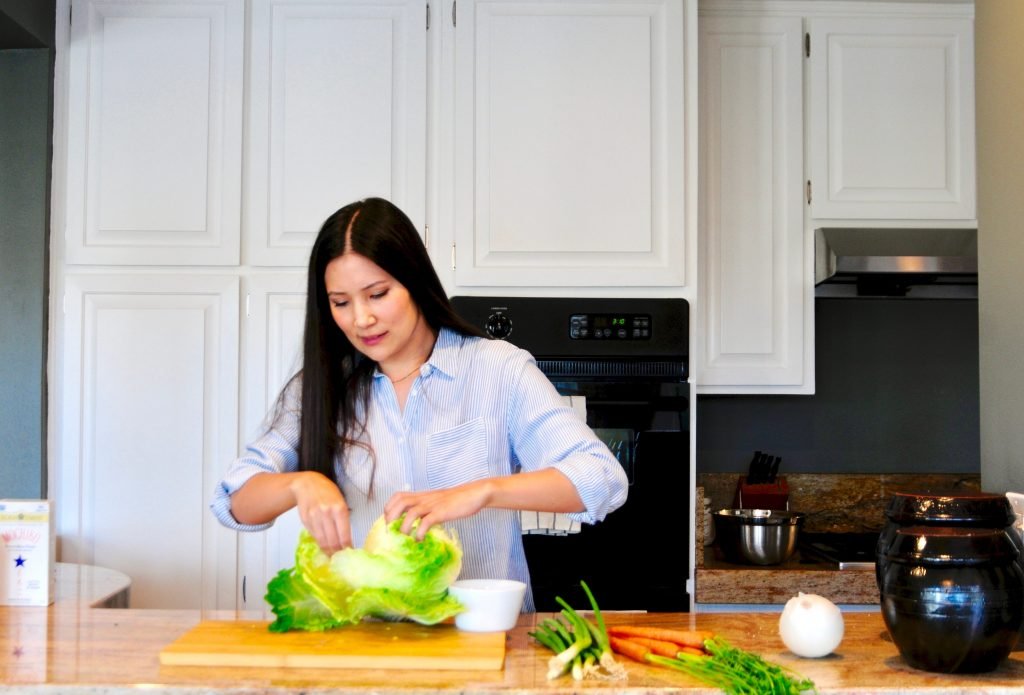
- Place cabbages in a large empty bowl or basin to rest for 2 hours. Turn them over every 30 minutes. Salty water will start to collect in the basin— this is what you want. Over the course of the 2 hours the cabbages will get very wilted and soft. *TIP* This is a good time to prepare the kimchi paste. See the next section.
- After the 2 hours is up, rinse the cabbages well in cold water to remove any residual salt. You should be able to split the halves into quarters by hand along the slits that were made earlier. Cut off the cores and discard. Place quarter cabbages in a strainer to drain.

PREPARE PASTE
- Add glutinous rice flour and water to a pot and simmer until it bubbles. I like to use a whisk to prevent clumping. The consistency should be similar to that of a syrup. Usually about 10 minutes.
- Add the brown sugar and stir until dissolved (1-2 minutes), then remove from heat.
- Transfer the mixture from the pot to a bowl to cool. While it is cooling, julienne the carrots and chop the green onions.
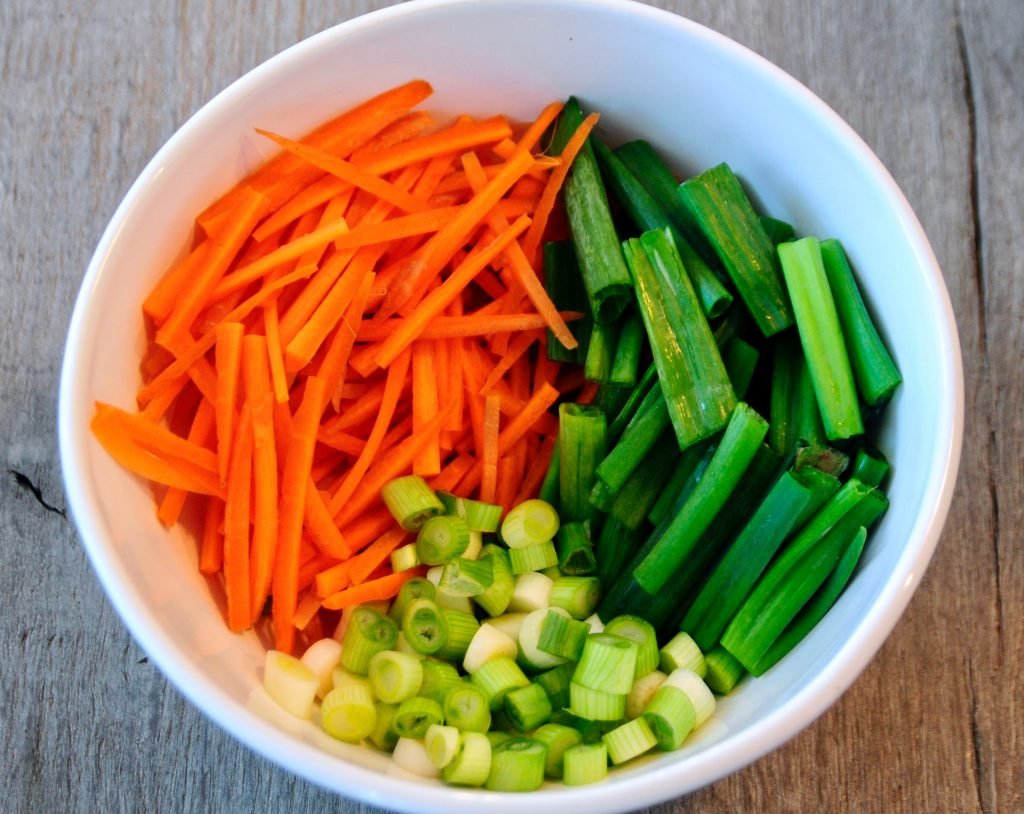
- Mince the garlic, ginger, and onion with a food processor, or by hand.
- Use your thumb and a 1/4 measuring cup to squeeze the juice of the shrimp into the paste. Chop the shrimp finely and add to the paste.
- Add the fish sauce, garlic, ginger, carrots, green onions, and gochugaru pepper flakes to the bowl with the paste base.
- Mix together well
PREPARE KIMCHI
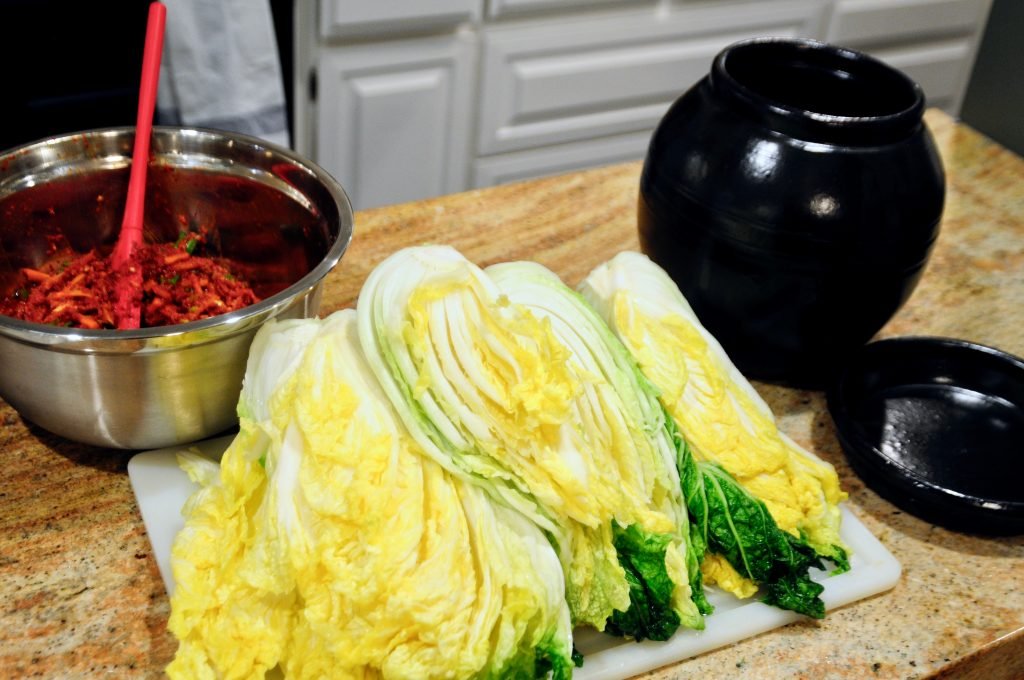
- Either by hand or with a brush, apply the kimchi paste to each leaf of cabbage— similar to how you salted each layer earlier. I would highly recommend food gloves for this.
- Once coated with paste, fold each cabbage quarter and pack into your fermentation vessel (onggi, tupperware, mason jar or container of choice). Pack the kimchi down tightly with your fist to remove air pockets.
- Set your fermentation vessel on a countertop in a room around 70-75 degrees Fahrenheit to ferment. The warmer the temperature, the faster it will ferment.

FERMENTATION
- *NOTE* If you are fermenting in an airtight vessel or container with a lid, make sure to “burp” the kimchi once a day to let the gases escape. If you are fermenting in onggi you do not need to worry about burping because the earthenware vessels are porous.
- My preference is to let the kimchi ferment on my kitchen counter for 3 days before checking and tasting it. Be warned, the smell is strong, but to me it is not unpleasant.
- After 3 days, check the kimchi. Use a spoon to push down on the kimchi until you see liquid. You should hear gurgling and see bubbles come to the surface if it is fermented.
- At this point, the kimchi is fermented and what you do next is really up to your personal preferences and taste. I like to leave my kimchi on the countertop for a few days to ferment more, but I never let it ferment at room temperature for longer than one week total. My ideal ferment is usually a total of 5-6 days on the counter. Once I am satisfied with my ferment, I transfer the kimchi to a large jar and store it in the refrigerator. It will continue to ferment, but the process will be much slower.
- Enjoy your homemade kimchi!
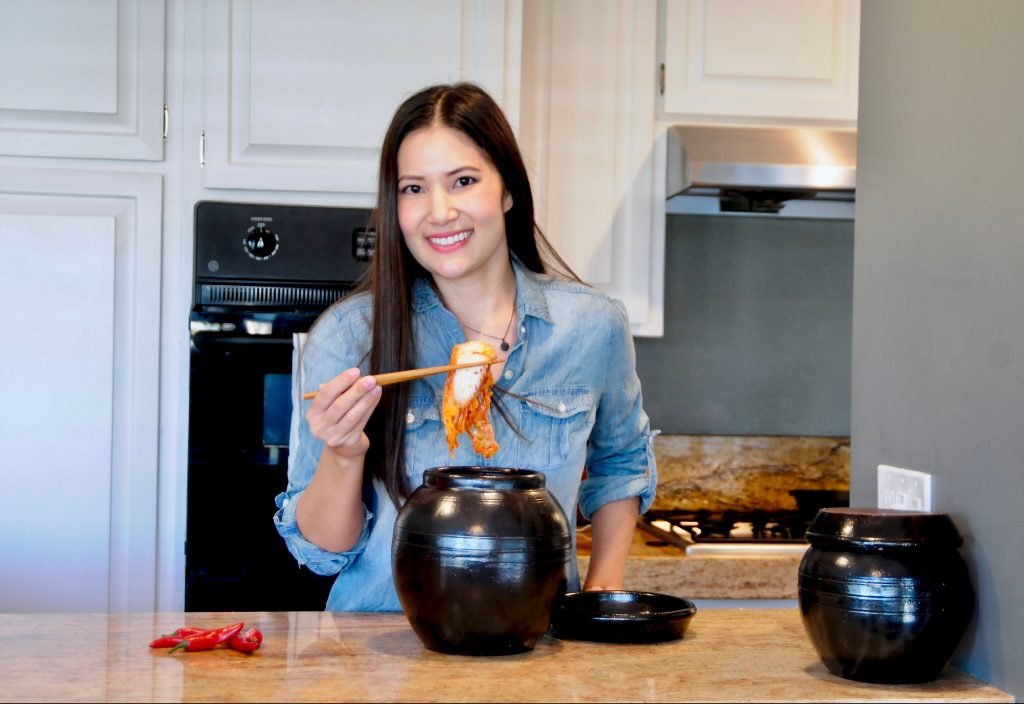
*Disclaimer: Some of the links above are affiliate links, and if you make a purchase through them I may earn a small commission at no cost to you. These products that I have chosen to link I have used myself and can attest to their quality based on my own experience with them. The opinions expressed on this site are my own.

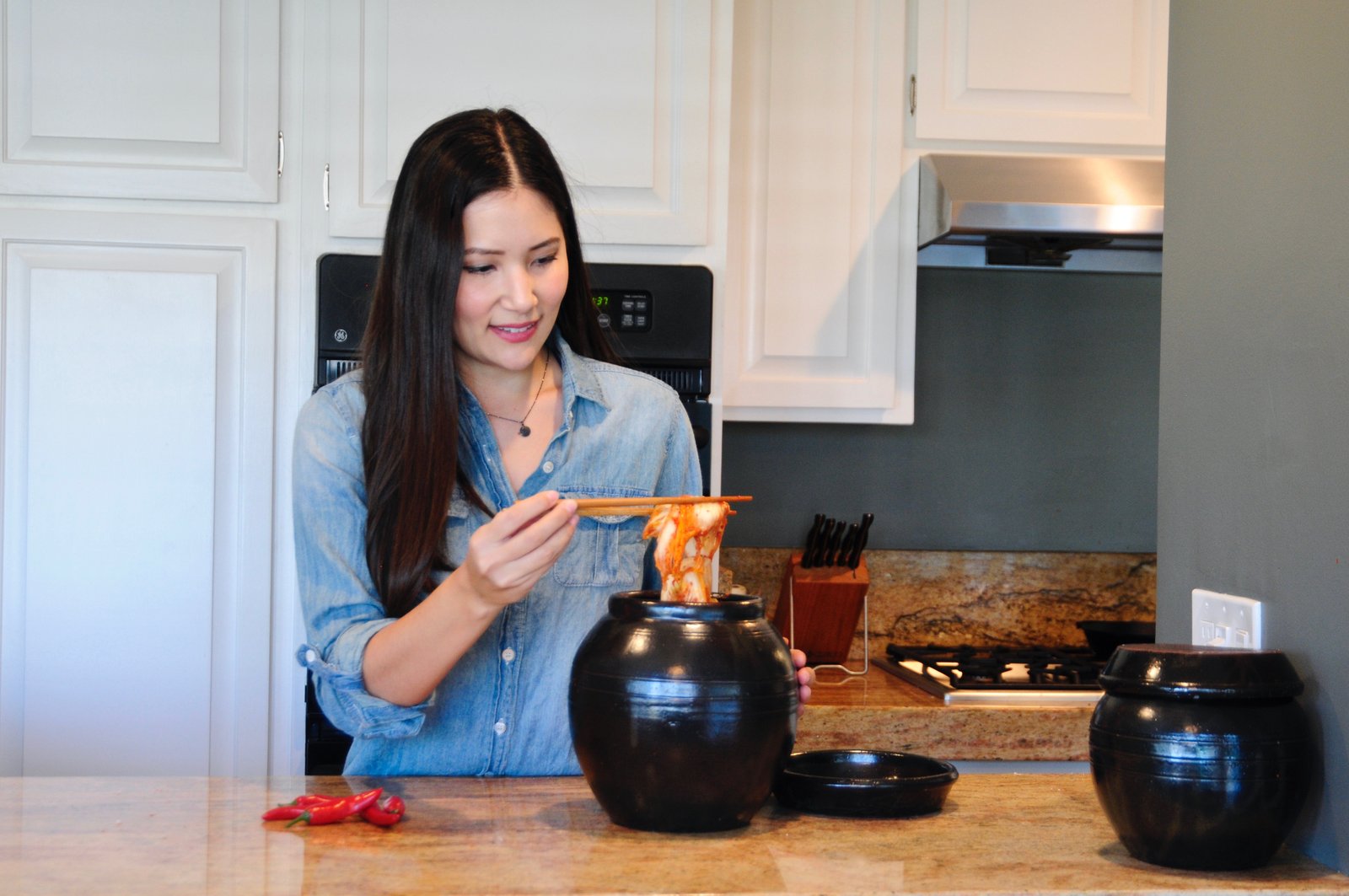
 How To Grow Your Own Potatoes
How To Grow Your Own Potatoes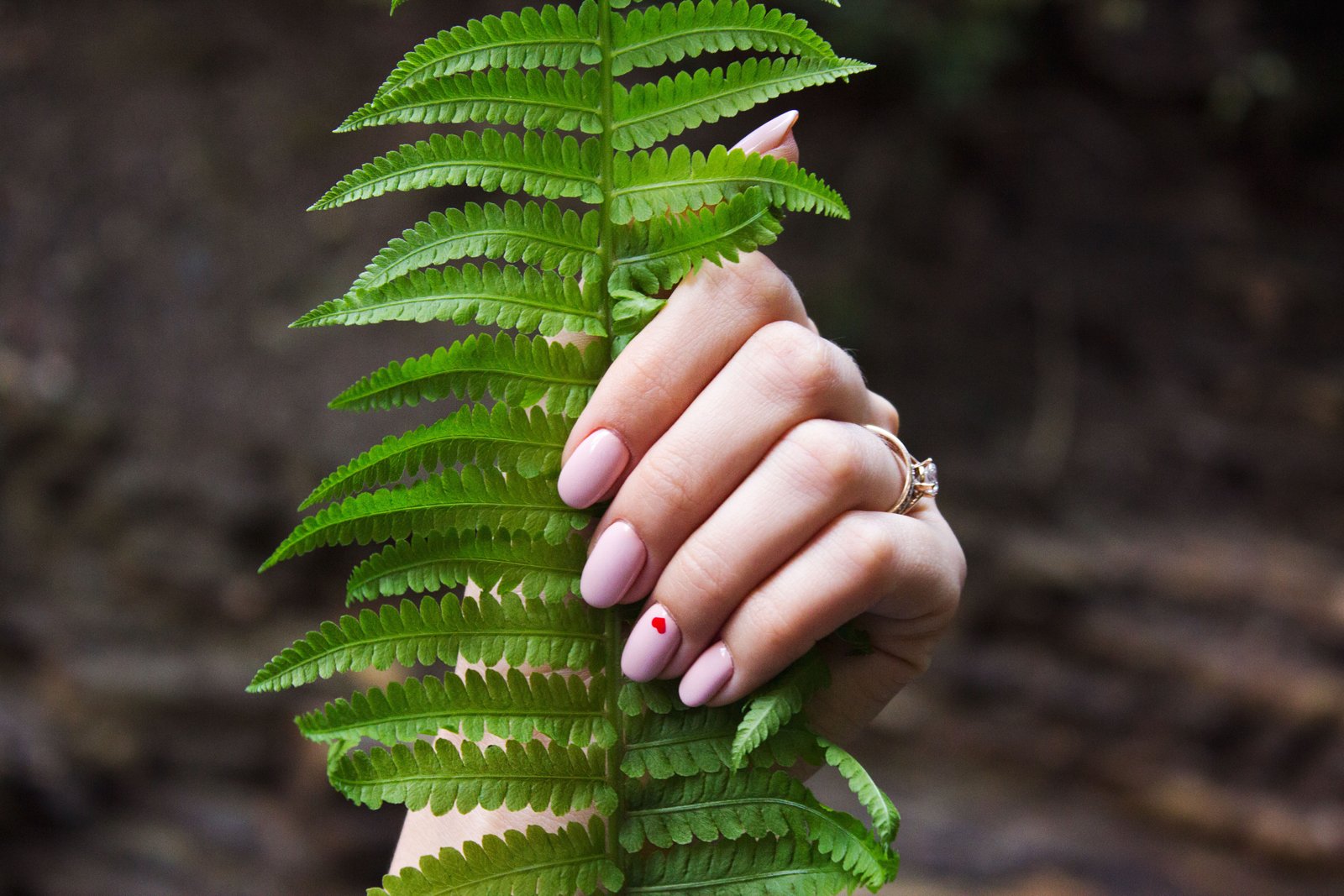
Omg…. this looks sooo yummy! I’m trying this recipe!
I’m so glad! Please come back and let me know what you thought after you try it! I’d love feedback! 🙂
Hi! I can’t wait to try this! I also wanted to say, as a half Korean, it’s so exciting to find another half Korean who’s interested in this stuff! I never really got to learn how to make kimchi from my family, so I’m looking forwards to learning now!
Hi! I love this! Thank you so much for the comment. I hope you like the recipe. I find making kimchi so therapeutic and I love the process. The recipe is totally customizable too to your taste. Would love to hear what you think after you try it. Good luck 🙂
Amber
Hi! I tried the recipe, and it worked perfectly! My family loved it. The one thing my grandma told me to do differently was salt the cabbage overnight; other than that it was great! I’m actually going to the grocery soon to get ingredients to make this again, haha.
Oh I’m SO SO glad you tried the recipe and loved it! Wow what a compliment 🙂 That’s so interesting about the salting overnight. I will have to give that a try and see how the flavor changes. Thank you so much for your feedback!
I love your kitchen and the ongii. I ordered mine from South Korea; looks great on my kitchen counter. Can’t wait to try your recipe. I am from Africa and I am obsessed with the Korean culture and cuisine. Will keep you updated on how it goes
That’s so wonderful to hear! Thank you so much 🙂 I hope you enjoy the recipe! Please let me know what you think once you try it!
Hi have you tried fermenting in the kind of onggi that has a ridge for pouring water to help seal the lid. What would be the best way to go about storing the kimchi in one of those? I’m getting ready to buy one and I’d like to know if these work as well. Thank you so much.
Hmm I’ve never used one of those before! That is really interesting. I’ve only ever fermented kimchi in a tupperware or an onggi. But you don’t need to actually “seal” anything. It’s important that the vessel is either breathable, or that you burp it to release the gases that build up during the fermentation process. Once the kimchi is made and I’m ready to store it, I just transfer it to a jar and move it into the fridge. The cool temperature slows down the fermentation process so you don’t need to worry about burping it at that point. I don’t know if that helps, but I hope it does! Best of luck! 🙂
Looks amazing. I live in the Philippines and can’t wait to scour the Korean used goods stores for Onggi. I hope I find one. Thanks for sharing
Hi Adit,
I am so excited for you! Were you able to get your hands on an onggi? Best of luck and please let me know what you think of the recipe!
-Amber
Hi, do you know where I can buy an onggi online? I have looked everywhere, but can’t find any online store that sells them
Adam Fields in Montana make Onggi handmade. He apprenticed in Korea. I paid $150 for a one gallon Onggi. He makes all sizes up to I believe 60 gallon. He has a website if interested. These are real authentic Onggi’s.
Thank you so much for letting me know! I will definitely have to check them out!
Hi! I have a question about onggis and submerging the kimchi. I’ve always made them in glass jars because they were always the easiest available, and always had a problem with the kimchi drying out on the top layer. I wanted to know if traditional onggis have a weight that goes inside to submerge the kimchi? I’ve seen some videos of women using an to dressing cabbage leaf with a rock. Or is it sufficient to just press the kimchi down periodically to keep juice on top.
My last batch I kept in an underground cellar in breathing jar and everything molded. I now onggis are buried in the winter, does the kiln firing keep this from being contaminated? Thanks you so much for your article, I really enjoyed it.
Hi Amber,
I just ordered an Onggi from Adam Fields and can’t wait to try your recipe!
Cheers,
Shawn